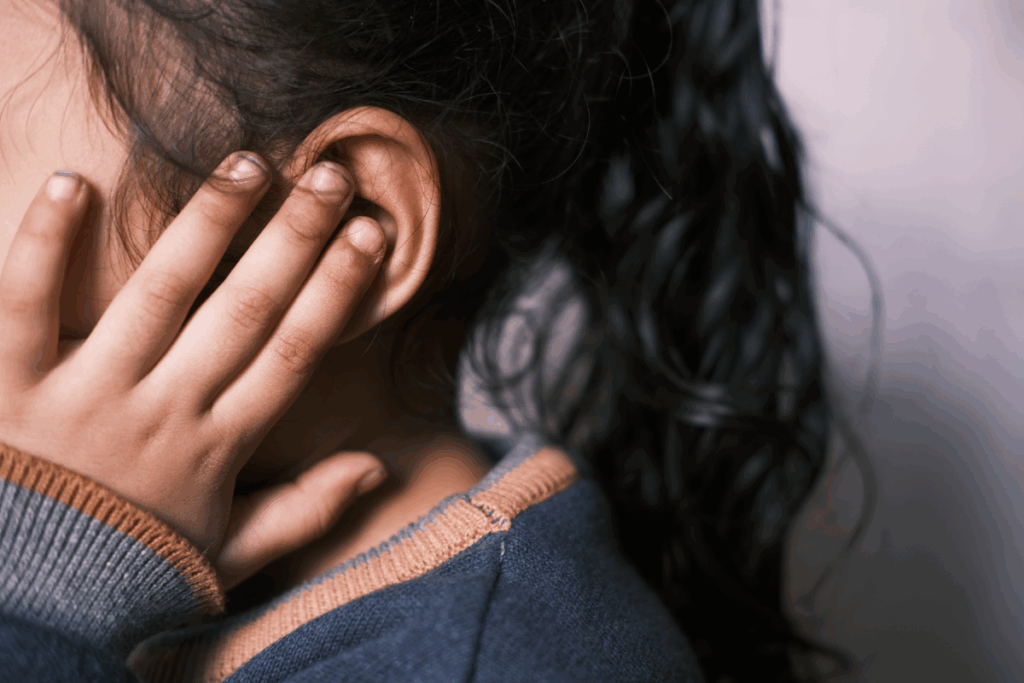
When toddlers get really fussy, pull at their ear, or can’t sleep, it might mean they have an ear infection. Ear infections are very common in kids. Many parents don’t know much about them.
The National Institutes of Health says that five out of six kids will get an ear infection before they turn three. Signs of an ear infection include being really upset, crying a lot, and pulling or rubbing their ears. They might also have trouble sleeping, eat less, and sometimes lose their balance. Parents need to know these signs. This way, they can spot otitis media symptoms early and get help if needed. Learn how toddlers act when they have ear infection symptoms and how to recognize the signs early. So lets check it out now
Toddlers often get ear infections, and it’s important to know why. These infections are common in young kids. They can make both the child and parents very uncomfortable.
Otitis media, or middle ear infection, is the most common ear infection. It happens when fluid builds up behind the eardrum. This makes the middle ear swell up, causing pain, fever, and irritability in toddlers.
Young children get ear infections often because their immune systems are not fully grown. Their eustachian tubes, which help drain fluid from the ear, are also smaller and less effective. This makes it easier for bacteria to cause infections.
So, many kids have their first ear infection before they are three years old.
The most common time for ear infections is between 6 and 18 months. During this time, kids’ immune systems are not strong enough to fight off infections. Their ear anatomy also makes them more likely to get fluid buildup and infections.
Parents should watch closely for signs of ear infections in this age group. They should seek ear infection treatment if symptoms don’t go away.
A good infected ear remedy includes both medical care and home treatments. Knowing the reasons and signs of ear infections helps parents take the best care of their toddlers.

It’s important to know the signs of ear infection in toddlers. This is because ear infections can be very uncomfortable. They can also lead to bigger problems if not treated right away.
Toddlers with ear infections often show physical signs. One common sign is when they tug or pull at their ear. This is their way of saying they’re in pain.
Other signs include fluid coming out of the ear and the outer ear looking red or swollen.
Ear infections can also make it hard for toddlers to hear. Parents should watch for any changes in how their child responds to sounds. Or if they seem to have trouble hearing.
Toddlers with ear infections might act differently, too. They might be more fussy or have trouble sleeping. They might also want to be held more than usual.
Some toddlers might have trouble balancing. This could mean the infection is affecting their inner ear. Watching for these changes can help spot an ear infection early.
Fever is a common sign of ear infections in toddlers. It means the body is fighting off an infection. Sometimes, the fever can be so high that antibiotics for an ar infection are needed.
Parents should keep a close eye on their toddler’s temperature. If the fever is high or lasts a long time, they should get medical help. Knowing how fever relates to ear infections can help manage the condition better.
Ear infections in young children are hard to diagnose because they can’t talk. Toddlers can’t say they’re in pain like older kids and adults do.
Figuring out ear infections in non-verbal toddlers is tough. Parents and caregivers need to be very observant. These kids can’t tell us they’re in pain, so we have to look for other signs.
Common indicators include: irritability, fussiness, and changes in appetite or sleep patterns. Some toddlers may also exhibit behavioural changes such as tugging or pulling at their ears.

Parents are key in spotting ear infections. They should watch for signs of discomfort, like ear tugging. They should also notice any changes in feeding habits or overall demeanour.
Ear infection symptoms can look like other common childhood illnesses. This makes it hard to tell them apart. For example, a cold or flu can cause fever and irritability, just like an ear infection.
To distinguish between these conditions, consider the presence of ear-specific symptoms like ear tugging and the overall clinical picture, including the severity and duration of symptoms.
Dealing with ear infections in young children requires a mix of medical help and home care. Knowing the different options helps parents make the best choices for their child.
Doctors often use antibiotics to fight bacterial ear infections. They might also suggest pain-relieving medications like acetaminophen or ibuprofen to help with pain. Sometimes, ear tubes are needed to drain fluid and prevent future infections.
If a viral infection causes the ear infection, antibiotics won’t work. Treatment then focuses on easing symptoms. It’s important for parents to work with their doctor to find the right treatment.
For ear infections, a team of healthcare professionals is best. This team includes pediatricians, ENT specialists, audiologists, and speech therapists. They work together to manage the infection and any related issues.
There are ways to make a child feel better at home. These include:
To stop ear infections from coming back, good hygiene is key. This includes washing hands often, avoiding smoke, and keeping up with vaccinations. Breastfeeding also helps protect against ear infections in babies. Some kids might need to use xylitol products to prevent infections.
By understanding treatment options and taking steps to prevent infections, parents can help their child get better. This also lowers the chance of future problems.
It’s important to know the signs of ear infections in toddlers. Severe ear pain, high fever, or discharge from the ear are warning signs. If your child shows these symptoms of ear infection, get medical help right away.
Ignoring ear infections can lead to serious problems. Staying alert to these symptoms and knowing when to act can help your child get better faster. It’s key to their health.
Toddlers with ear infections might seem irritable or cry a lot. They might also tug at their ears or have a fever. Sleep problems and changes in behaviour, like being fussier or eating less, are signs too.
Toddlers get ear infections more often because their immune systems are not fully grown. Their eustachian tubes are also different, making it easier for germs to get into their ears.
Look for signs like ear tugging, fever, and changes in how they act. If you notice these, it’s best to talk to a doctor to figure out what’s wrong.
Doctors might give antibiotics to fight the infection. They might also suggest ways to manage pain. Sometimes, they just wait to see if the infection goes away on its own.
Use medicines like acetaminophen or ibuprofen to help with pain. Keep their ear dry and make sure they rest a lot. Always check with a doctor for the best care plan.
While you can’t stop all ear infections, some steps can help. Breastfeeding, avoiding smoke, and keeping up with vaccines can lower the risk of getting them again.
Watch for high fever, severe ear pain, or discharge from the ear. If your child seems confused, has a stiff neck, or has trouble balancing, get them help right away.
Inner ear infections, or labyrinthitis, can mess with balance and hearing. They’re not as common as middle ear infections, but they need quick medical attention because they can be serious.
If ear infections keep coming back, they can cause hearing problems or speech delays. Regular doctor visits can help prevent these issues.
Paul, C. R., et al. (2020). Acute otitis media. JAMA Pediatrics, 174(3), 299-306. https://jamanetwork.com/journals/jamapediatrics/fullarticle/2759422Jamal, A., et al. (2022). Etiology, diagnosis, complications, and management of acute otitis media in children. International Journal of Pediatrics, 10, Article 5474832. https://www.ncbi.nlm.nih.gov/pmc/articles/PMC9471510/Gaddey, H. L., & Willis, R. W. (2019). Otitis media: Rapid evidence review. American Family Physician, 100(6), 350-356. https://www.aafp.org/pubs/afp/issues/2019/0915/p350.html
Subscribe to our e-newsletter to stay informed about the latest innovations in the world of health and exclusive offers!
WhatsApp us